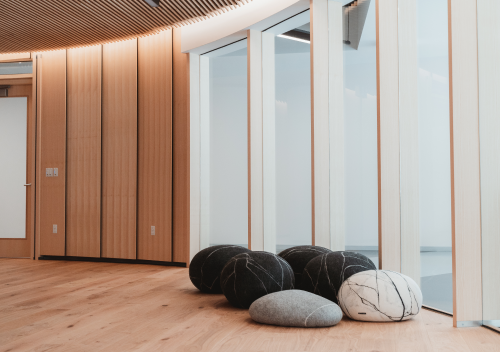PÎYÊSÎW WÂSKÂHIKAN | Thunderbird House
Located at the revitalized Stanley A. Milner Library, PÎYÊSÎW WÂSKÂHIKAN (Thunderbird House) is our first dedicated Indigenous space that is built for ceremony and gatherings.
From the design of the space to the classes and programs being offered, this space is for the community. We hope that it is welcoming and accessible for all customers. As a community-led library system, PÎYÊSÎW WÂSKÂHIKAN will work with local Elders and Knowledge Keepers and Indigenous organizations to offer programming that is welcoming to Indigenous and non-Indigenous peoples.

When asked what the community would like to see in this space, we consistently heard:
- Language programming
- Cultural and land-based teachings
- Intergenerational programming
While programming and events will occur in the space, we also want PÎYÊSÎW WÂSKÂHIKAN (Thunderbird House) to be an urban refuge for people to be able to come smudge and have a quiet place to reflect.
What is smudging?
Smudging is a burning of medicine (sweetgrass, cedar, sage, fungus, etc.) that is then washed over someone, by themselves or by someone else. This serves as both a cleansing and transport of prayers to above. Smudging is a component of Indigenous ceremonies, as well as prayer by an individual or small group.
The name PÎYÊSÎW WÂSKÂHIKAN is in nêhiyawêwin (Plains Cree), a language Indigenous to Edmonton, and translates to Thunderbird House. Thunderbirds are an important deity to nehiyawak (Plains Cree people) and have a significant relationship with the buffalo who sustained life for prairie Indigenous people for thousands of years.
The name was gifted to the space by Elders Jerry and Jo-Ann Saddleback in a pipe ceremony in August 2020.

How to Write the Name
There are two ways to write in nêhiyawêwin so you will notice the name is depicted in two ways on the sign: one using the standard alphabet and the other using syllabics. Syllabics are an ancient writing system gifted to nehiyawak and contain spiritual powers.
How to Say the Name
There are sounds within nêhiyawêwin that don’t exist in English, but an approximate way to pronounce the name is:
PEE-YE-SOU WAASK-A-HIGAN
Elder Jerry Saddleback sharing the pronunciation of PÎYÊSÎW WÂSKÂHIKAN.
Thunderbird House - FAQs
-
The walls, ceiling and floor are all made of white poplar, which is a significant tree to all Indigenous nations in the Edmonton-area. The doors of the space are on the south and east sides, with abundant windows to let in natural light. The windows of the space feature an art installation by Joi T. Arcand that showcases the name Elders Jo-Ann and Jerry Saddleback gave to the space. The space contains a dedicated air circulation system that can allow people to smudge everyday without shutting off the fire alarm system.
-
Everyone can learn, gather and reflect in PÎYÊSÎW WÂSKÂHIKAN. Though the space is built with Indigenous design and ceremony in mind, we recognize that many non-Indigenous EPL customers are very interested in participating in Indigenous and reconciliation-focused events and programming and we encourage this practice.
-
PÎYÊSÎW WÂSKÂHIKAN was specifically built for everyday smudging that does not require shutting down the fire alarm system. We welcome people to come to the space and learn about smudging and its importance to Indigenous peoples.

